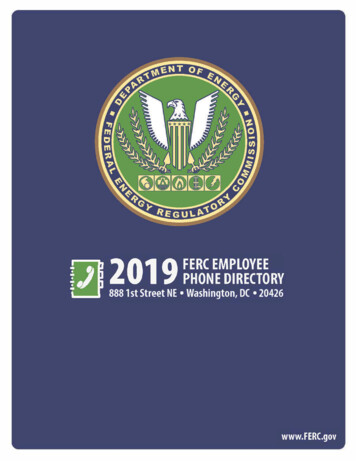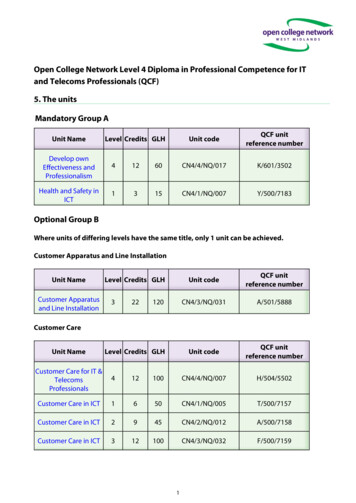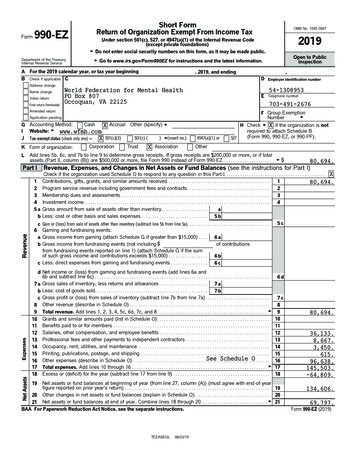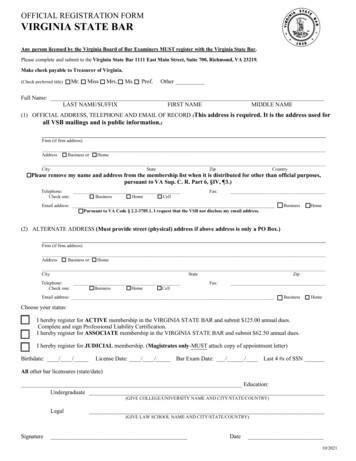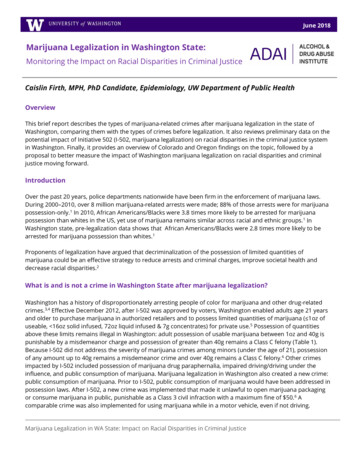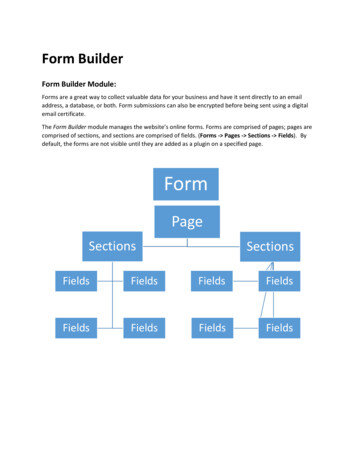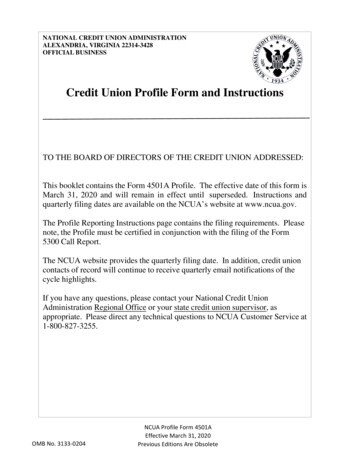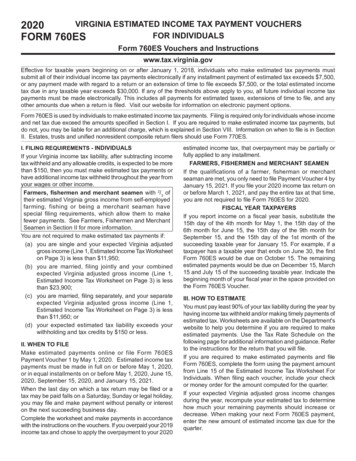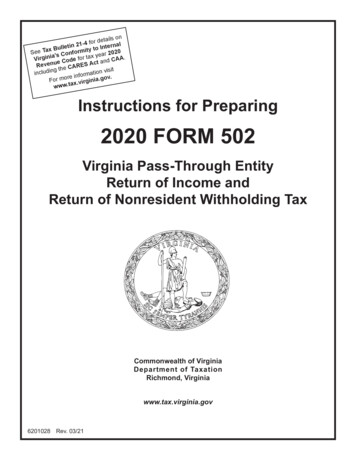
Transcription
s onr detail lfo41tin 2ternax Bulley to InSee Ta ’s Conformit year 2020xVirginia Code for taCAA.uect andnAeSveERARg the Cvisitincludinmation .rfoinervFor mo x.virginia.goa.twwwInstructions for Preparing2020 FORM 502Virginia Pass-Through EntityReturn of Income andReturn of Nonresident Withholding TaxCommonwealth of VirginiaDepartment of TaxationRichmond, Virginiawww.tax.virginia.gov6201028Rev. 03/21
Table of ContentsWHAT’S NEW. 1Advancement of Virginia’s Fixed Date Conformity with the Internal Revenue Code. 1New Reason Codes for Amended Returns. 1Report of Change in Federal Taxable Income. 1New Forms 502FED-1 and 502FED-2 for Partnership-Level Entity Amended Returns. 1New Addition and Subtraction Codes Related to Partnership-Level Federal Adjustments. 1Communities of Opportunity Tax Credit Changes. 1Green Job Creation Tax Credit Sunset Date Extension. 1Motion Picture Tax Credit Changes. 2Recyclable Materials Processing Equipment Tax Credit Changes. 2Research and Development Tax Credits Changes. 2GENERAL INFORMATION. 3Pass-Through Entities Required to File. 3Withholding Tax Payments for Nonresident Owners. 3Accounting Method. 5Allocation and Apportionment. 5General Filing Requirements. 5Unified Nonresident Individual Income Tax Return (Composite Return). 8INSTRUCTIONS FOR PAGE 1 OF FORM 502. 9Taxpayer Information . 9Number and Types of Owners. 10Entities Exempt From Withholding . 10Distributive or Pro Rata Income and Deductions. 10Allocation and Apportionment.11Virginia Modifications to Income (Additions and Subtractions). 12Virginia Tax Credits . 13INSTRUCTIONS FOR PAGE 2 OF FORM 502. 13Section 1 – Withholding Payment Reconciliation. 13Section 2 – Penalty and Interest Charges on Withholding Tax. 14Section 3 – Penalty for Late Filing of Form 502. 14Section 4 – Withholding Overpayment. 14Section 5 – Tax, Penalty, and Interest Due. 14Section 6 – Amount Due or Refund. 14INSTRUCTIONS FOR SCHEDULE 502ADJ. 15Sections A and B – Virginia Modifications. 15Section A – Addition Codes. 15Section B – Subtraction Codes. 16Section C – Virginia Tax Credits. 18Section D – Amended Return. 20INSTRUCTIONS FOR VIRGINIA SCHEDULE VK-1 AND SCHEDULE VK-1 CONSOLIDATED . 20Additional Owner Information. 20Line Instructions. 21INSTRUCTIONS FOR SCHEDULE 502A. 21Section A – Apportionment Method. 22Section B – Apportionment Percentage. 24Section C – Allocable and Apportionable Income. 26
What’s NewAdvancement of Virginia’s Fixed Date Conformity with the Internal Revenue CodeVirginia will continue to deconform from the following: bonus depreciation allowed for certain assets under federal law; thefive-year carryback of certain federal net operating loss (NOL) deductions generated in the 2008 or 2009 taxable years; thefederal income treatment of applicable high yield discount obligations; and the federal income tax treatment of cancellationof debt income realized in connection with certain business debts.New Reason Codes for Amended ReturnsTaxpayers filing amended returns must now use a code to indicate the reason the return is being amended. See Page 9 ofthese instructions for a list of the new amended reason codes.Report of Change in Federal Taxable IncomeRecent legislation clarifies when taxpayers must report federal adjustments to the Department, effective July 1, 2020. If theadjustment results in an increase in the taxpayer’s Virginia income tax liability, additional tax may be due at the time when thechange is reported. If the adjustment results in a decrease, the taxpayer may be entitled to a refund. These adjustments aremost commonly the result of either an audit by the IRS or the filing of an amended federal income tax return by the taxpayer.New Forms 502FED-1 and 502FED-2 for Partnership-Level Entity Amended ReturnsIf (1) changes or corrections have been made by the Internal Revenue Service or other competent authority, or as the resultof a renegotiation of a contract or subcontract with the United States, and (2) the final determination date is on or after July1, 2020, the partnership is required to file an amended Virginia return. Affected partnerships must submit the new Form502FED-1, Virginia Partnership-Level Federal Adjustments Report, within 90 days of the federal determination date toreport adjustments to Virginia income as a result of the federal audit. The resulting tax due must be submitted within oneyear of the final determination date. See the Form 502FED‑1 Instructions for more information.Partnerships can elect to calculate and pay any resulting tax on the entity level. If a partnership elects to pay tax on the entitylevel, it must submit Form 502FED-2 in lieu of completing an amended Form 502. See the Form 502FED-2 Instructions foradditional information.New Addition and Subtraction Codes Related to Partnership-Level Federal AdjustmentsIf a partner is required to amend its Virginia return because of partnership-level federal adjustments, use new addition orsubtraction codes. See the instructions for the Schedule 502ADJ, starting on Page 15 of this booklet.Communities of Opportunity Tax Credit ChangesFor taxable years beginning on or after January 1, 2020, but before January 1, 2025, landlords renting a qualified housingunit located in an eligible census tract within the Washington-Arlington-Alexandria Metropolitan Statistical Area may qualifyfor the Communities of Opportunity Tax Credit. Under prior law, only landlords with qualified housing units located on eligiblecensus tracts within either the Richmond Metropolitan or Virginia Beach-Norfolk-Newport News Metropolitan Statistical Areasqualified for the credit. See Schedule 500CR Instructions for more information.A sunset date of January 1, 2025, has been imposed on the credit.Green Job Creation Tax Credit Sunset Date ExtensionThe sunset date for the Green Job Creation Tax credit has been extended from January 1, 2021, to January 1, 2025.Page 1
What’s New (Continued)Motion Picture Tax Credit ChangesFor taxable years beginning on and after July 1, 2020, but before January 1, 2027, the Virginia Film Office within the VirginiaTourism Authority may issue and a taxpayer may claim Motion Picture Production Tax Credits in future fiscal years otherthan the taxable year in which the Virginia production activities are completed. The Department is prohibited from payinginterest on any prospective or future credits issued. See Schedule 500CR Instructions for more information.The sunset date for the credit has been extended from January 1, 2022, to January 1, 2027.Recyclable Materials Processing Equipment Tax Credit ChangesFor taxable years beginning on and after January 1, 2020, but before January 1, 2025, taxpayers may claim the RecyclableMaterials Processing Equipment Tax Credit for machinery and equipment used predominantly in or on the premises offacilities that are predominantly engaged in advanced recycling. Advanced recycling is defined as the operation of a singlestream or multi-stream recycling plant that converts waste materials into new materials for resale by processing them andbreaking them down into their raw constituents. This includes the operation of a materials recovery facility or materialsreclamation facility that receives, separates, and prepares recyclable materials for sale to end-user manufacturers. SeeSchedule 500CR Instructions for more information.The sunset date for the Recyclable Materials Processing Equipment Tax Credit has been extended from January 1, 2020,to January 1, 2025.Research and Development Tax Credits ChangesThe application due date for the Forms MRD and RDC has been extended from July 1 to September 1 of the calendaryear following the close of the taxable year in which expenses related to these credits were paid or incurred. See Schedule500CR Instructions for more information.The sunset date for both credits has been extended from January 1, 2022, to January 1, 2025.AssistanceOnline Resources:The Department’s website, www.tax.virginia.gov, contains valuable information to help you. Online Services – Link to online registration, filing, payment, and other electronic services. Laws, Rules, & Decisions – Access the Code of Virginia, Tax Regulations, Legislative Summaries, Rulings by the TaxCommissioner, Tax Bulletins, and Attorney General Opinions. Email Updates – Sign up and stay informed. By subscribing, you will periodically receive automatic email notificationsregarding legislative changes, filing reminders, and other relevant information.Contact Us:Customer Service InquiriesForms RequestsDepartment of TaxationP.O. Box 1115Richmond, Virginia 23218-1115Department of TaxationP.O. Box 1317Richmond, Virginia 23218-1317Phone: (804) 367-8037Fax: (804) 254-6111Phone: (804) 367-8037or visit www.tax.virginia.govPage 2
Instructions for Preparing 2020 Form 502Virginia Pass-Through Entity Return of Income and Return of Nonresident Withholding TaxGENERAL INFORMATIONPass-Through Entities Required to FileEvery pass-through entity (PTE) doing business in Virginiaor having income from Virginia sources is required toelectronically file a Form 502 for each taxable year.Pass-through entities include S corporations, bilitypartnerships (LLPs), limited liability companies (LLCs),electing large partnerships, and business trusts. A PTE isany entity that is recognized as a separate entity for federalincome tax purposes and the entity’s owners report theirdistributive or pro rata shares of the entity’s income, gains,losses, deductions, and credits on their own income taxreturns. Unlike C corporations, a PTE typically does notpay income tax itself; rather, the entity’s income and relateditems are reported by the owners on their personal returnsand the tax is computed and paid at the owner level. Estatesand trusts that file Virginia Form 770 are not subject to theForm 502 filing requirements.An owner of a PTE may be an individual, a corporation, apartnership, or any other type of entity that is treated as ashareholder, partner, or member of a PTE for federal incometax purposes.An owner of a PTE may itself be a PTE and have otherpass-through entities as its owners so that income, gains,losses, and deductions may pass through several levelsof ownership before reaching an owner that is taxable. Allpass-through entities that are subject to filing in Virginia arerequired to file their own returns regardless of the ownershiphierarchy. There are no “consolidated” or “multilevel” PTEreturns.A PTE has Virginia source income if it has:1. Any items of income, gain, loss, or deduction related toeither:a) the ownership of real or tangible personal property inVirginia, orb) a business, trade, profession, or occupation carriedon in Virginia;–OR–2. Any income or gain from intangible property to the extentthat such property is used by the entity in a business,trade, profession, or occupation carried on in Virginia.If a PTE does not conduct its entire business within Virginia,then it must determine the Virginia-source portion of itstotal income through allocation and apportionment. SeePages 5, 11, and 22 for more information on allocationand apportionment. In general, a non-Virginia entity willhave income from Virginia sources if it has enough activityor presence in Virginia to make any apportionment factor(property, payroll, or sales) positive. Therefore, it maybe deemed to have Virginia-source income under theapportionment formulas even if no specific portion of itsgross or net income is separately identifiable as beingderived directly from Virginia.Single-Member LLCA single-member LLC that is disregarded as a separateentity for federal income tax purposes will be similarly treatedfor Virginia income tax purposes. Its income, gains, losses,and deductions will be included with those of its owner onthe owner’s income tax return. The disregarded entity is notrequired to file Form 502.Investment Pass-Through EntitiesPrevious rulings of the Tax Commissioner have held thatpass-through entities that are established solely to invest inintangible personal property, such as stocks and bonds, andthat have no employees and no real or tangible property, arenot considered to be carrying on a trade or business. Thus,the income from the intangible property that is held by aninvestment PTE is not income from Virginia sources, andthese types of pass-through entities are not required to fileForm 502.Period Covered by the ReturnA PTE’s taxable year for Virginia purposes is the same as itstaxable year for federal income tax purposes.Withholding Tax Payments for Nonresident OwnersEvery PTE that does business in the Commonwealth andhas taxable income derived from Virginia sources mustwithhold and pay Virginia income tax on behalf of each ofits nonresident owners, unless the entity or the owner meetsan exception. See the section heading “Exceptions to theRequirement for Withholding.” If an owner was a nonresidentowner for only a portion of the taxable year, the incomeallocated to such owner must be prorated by the number ofdays of residence outside of Virginia in order to determinethe amount on which the withholding tax must be paid.The tax is equal to 5% of the share of taxable income fromVirginia sources that is allocable to each nonresident owner.In determining the amount of tax, the entity may apply anytax credits that pass through to nonresident owners, but thetax liability of any nonresident owner may not be reducedto less than zero. To avoid penalties, the payment mustbe equal to the lesser of: 90% of the withholding taxliability that was reported for the current taxable yearor 100% of the withholding tax liability reported for theprevious taxable year, provided that the return for theprevious year covered a 12-month period and reflecteda withholding tax liability.Page 3
Due Date for Paymenttaxes, or whose credit for taxes paid to other states issufficient to offset all Virginia income tax attributable tothe shares of income distributed by the PTE;Payment of the withholding tax is due by the original duedate for filing Form 502 (i.e., April 15 for a calendar yearreturn). The automatic 6-month filing extension for Form 502does not apply to the withholding tax payment. If the entitychooses to use the automatic filing extension for Form 502,the withholding tax payment must be submitted electronicallyno later than the original due date for filing Form 502.(2) individuals included on a composite return (Form 765);(3) entities other than individuals and corporations thatare exempt from paying federal income taxes byreason of their purpose or activities;(4) real estate investment trusts (REITs) that are notCaptive REITs; andPenalties and InterestIf a PTE that is subject to the withholding tax requirementfails to pay the minimum tax amount described above bythe original due date, penalties may apply. The penalties arecomputed in the same manner as the extension penalty andlate payment penalty for individual income taxes. The latefiling penalty is computed in the manner prescribed underVa. Code § 58.1-394.1.(5) corporations exempt from Virginia income tax.The exemption from federal income tax for entities otherthan individuals and corporations must apply to the entity’sshare of the PTE’s income.Examples of such exempt entities include:(1) Other PTEs. Generally, a PTE does not need towithhold for a nonresident owner that is also a PTE.These nonresident owner PTEs are responsible forfiling their own PTE returns of income and must pay thewithholding tax for their nonresident owners’ shares ofincome from Virginia sources. If a PTE is notified bya nonresident owner PTE that the nonresident ownerPTE is not going to file a Virginia PTE return, then thePTE is required to withhold on the nonresident ownerPTE.If Form 502 is filed within the 6-month extension period, butthe required minimum withholding tax amount was not paidby the original due date, the extension penalty will apply. Theextension penalty is imposed at the rate of 2% per monthor part of month on the balance of the tax due from the duedate through the date the return is filed, up to a maximum of12% of the tax due.If Form 502 is filed within the 6-month extension period andfull payment is not included with the return, the late paymentpenalty will apply. The late payment penalty is imposed atthe rate of 6% per month from the date of filing of Form 502through the date of payment, up to a maximum of 30% ofthe tax due. If the entity fails to pay the minimum tax amountrequired as described AND fails to make full payment witha return filed within the 6-month extension period, both theextension penalty and the late payment penalty will apply.The extension penalty will be imposed from the original duedate through the date that the return is filed, and the latepayment penalty will begin to accrue on the day after thereturn is filed.CAUTION: As a general rule, a PTE should notwithhold tax on behalf of another PTE. If a PTE doeswithhold on a nonresident owner PTE, the nonresidentowner PTE cannot claim credit on its Form 502 forsuch withholding. PTE withholding is not “generationskipping” and does not pass through an intermediatePTE to owners that are more than one level ofownership away. In the event that a PTE erroneouslywithholds for a nonresident owner PTE, the PTEshould file an amended Form 502. See the amendedreturns section for additional information.If Form 502 is filed more than 6 months after the due dateor more than 30 days after the federal extended due date,whichever is later, the greater of the late payment penalty,imposed at the rate of 30% of the tax due, or a late filingpenalty of 1,200 will apply.(2) Entities that are exempt by reason of diplomaticimmunity or pursuant to treaties between the UnitedStates and other countries. An entity claiming thisexemption must provide a statement to the PTEstating that it has diplomatic immunity from federalincome tax.Any balance of unpaid tax is also subject to accrual ofinterest at the rate specified under IRC § 6621, plus 2%,from the due date until the date of payment. For detailson computing the penalty and interest charges, see theline‑by‑line instructions for Page 2 of Form 502.(3) Any nonresident person who is a part of a PTE thatowns and leases 4 or fewer dwelling units in theCommonwealth, provided that the PTE discloses thename and federal taxpayer identification number forall such owners in its return for the taxable year filedunder Va. Code § 58.1-392. For this purpose, the term“person” is defined using the definition of “person” inVa. Code § 55-248.4.Exceptions to the Requirement for WithholdingPublicly traded partnerships and disregarded entities are notsubject to the withholding requirement. A PTE with an ownerthat is a disregarded entity does not withhold on behalf of thedisregarded entity. The disregarded entity does not withholdon behalf of its individual owner. For all other pass-throughentities, no withholding of Virginia income tax is required onbehalf of the following nonresident owners:(1) individuals who are exempt from paying federalincome taxes, who are exempt from Virginia incomeSee the Laws, Rules, & Decisions page on the Department’swebsite for any additional exceptions that may apply.If paying the withholding tax imposes an undue hardshipon the PTE, the PTE may request a waiver of the paymentrequirement. To request a waiver, the PTE must write aletter to the Tax Commissioner describing the facts andPage 4
circumstances creating the hardship. The letter must provideinformation to enable the Tax Commissioner to compareand evaluate the cost of the PTE’s compliance with thewithholding requirements and the cost to the Commonwealthof collecting income tax from any nonresident owners thatdo not voluntarily file Virginia income tax returns and paythe tax.To indicate an exception for the PTE, the entity must enterthe appropriate exception code on Form 502, Line d.To indicate an exception for the entity or for any or allnonresident owners, the entity must enter the appropriateexception code on Line f of the nonresident owner’s ScheduleVK-1, and enclose a list of all of the nonresident owners thatare claiming an exception to the Form 502. See Page 10 ofthese instructions for a list of exemption codes.Certified Company Apportionment for BusinessConducted in Certain Disadvantaged LocalitiesCertain companies may decrease the amount of theirincome taxed by Virginia when they meet specific eligibilityrequirements and are certified by the Virginia EconomicDevelopment Partnership Authority (VEDP). This includes arequirement that a specified number of jobs be created and, ifapplicable, investments be made in particular disadvantagedlocalities.A PTE’s accounting method for its Virginia return of incomeis the same as its accounting method for federal income taxpurposes.Once the company is certified by VEDP as meeting theapplicable eligibility requirements, it is entitled to decreasethe amount of income taxed by Virginia. For multistatecertified companies, the decrease in income is accomplishedby allowing such companies to make modifications to theirapportionment factors (“Certified Company Apportionment”).For instate certified companies, this is accomplished byallowing such companies the ability to use apportionmentand to use Certified Company Apportionment to makemodifications to their apportionment factors. See Schedule500AP Instructions for detailed information.Allocation and ApportionmentGeneral Filing RequirementsIf a PTE’s entire business is conducted within Virginia,then all of its income is Virginia source income; no incomeis allocated to another state, and the entity’s Virginiaapportionment is 100%.When to FileAccounting MethodIf a PTE conducts its business in Virginia and elsewhere ina manner such that its income would be subject to a taxon net income in Virginia and at least one other state, theentity must allocate and apportion its income in the samemanner that is provided in Virginia law for corporations. Thisapplies to all types of pass-through entities (partnerships,LLPs, LLCs, and S corporations). Dividends received are tobe allocated to the state of commercial domicile, but all otherincome must be apportioned. An entity may not apportionits income based on divisional or separate accounting,or any other alternate method unless it has requestedand received permission to do so in advance from theDepartment.The effect of the PTE’s apportionment may vary from oneowner to another, depending on the entity types of theowners. For instance: a Virginia resident individual owner is taxable on allof his or her PTE income regardless of the entity’sapportionment; a nonresident individual owner uses the entity’sVirginia apportioned income in determining his or herown Virginia nonresident percentage; and a corporate owner may need to include the PTE’sproperty, payroll, and sales factors in determining itsown apportionment percentage.The PTE return must be submitted on or before the 15th dayof the 4th month after the close of the entity’s taxable year.How to FileThe Department requires that all pass-through entities (PTEs)file their withholding tax payments, extension payments,annual tax returns, and final payments electronically. Thereare two options available. Returns may be filed throughthe Federal/State e-File program, or certain Virginia PTEsmay qualify to electronically file a Form 502EZ using theeForms system on the Department’s website. If the PTE isunable to file and pay electronically by the effective date, thePTE may request a waiver. Visit the Department’s websiteat www.tax.virginia.gov to access a waiver form and themailing address.e-File (Form 502)The e-File system is supported by numerous commercialsoftware programs. e-File software will automatically checkfor completeness, correct errors, generate the applicableschedules, and electronically transmit the return andpayment to the e-File processing systems. A list of approvedcommercial software is available on the Department’swebsite. If a tax due payment is required, the payment canbe made through the e-File system as a direct debit by usingeForms or with an ACH credit established through the PTE’sbank.In order to successfully e-File, the pass-through entity must:For more information on allocation and apportionment, seeSchedule 502A and the Instructions for Schedule 502Asection contained in these instructions.Page 5 Use an approved commercial e-File software product.Approved e-File software is listed on the Department’swebsite. You must be able to create a readable PDF file for anydocument or schedule that is required for backup tothe return. You must either have a scanner that allows
you to scan documents into a PDF file or software thatallows you to save a file as a PDF document. Thisfeature will allow you to e-File your state return if theInternal Revenue Service (IRS) does not support thefederal return and/or schedules through the federale-File system by attaching the federal return as
year of the final determination date. See the Form 502FED-1 Instructions for more information. Partnerships can elect to calculate and pay any resulting tax on the entity level. If a partnership elects to pay tax on the entity level, it must submit Form 502FED-2 in lieu of completing an amended Form 502. See the Form 502FED-2 Instructions for
